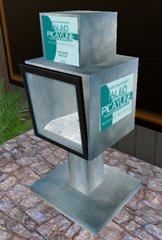An SLEDitorial by Chris Swaine
Learning Environment: As an alternative learning environment, it provides:
an alternative and potentially neutral space away from the 'traditional' classroom, which can be socially inclusive for those learners which the formal establishment has woefully failed.
enables real time interactions and global alliances which are not constrained by traditional 'location' based environments.
In 20 years time, we will laugh at what we now call a VLE [Blackboard, WebCT, Moodle etc etc] as being very quaint and 2D
Support Networks.
Formal and informal, multiple support networks - from peer to peer through to trusted intermediaries - through to synchronous and asynchronus communication channelsCollaborative space. One of SL's huge benefits is the collaboration - both for learners and educational practitionersLearning & Teaching Dynamic
Enable all learners to experience a greater variety of teaching and learning styles - fab for kinesthetic and audio visual styles!Can help to blur the distinction between the role of the teacher and learner.Different opportunty for greater range of interactions with the teacherThe traditional role of the teacher and the learner can become blurred, which potentially puts the learner more in control of their own learning [andragogic /heutagogic approaches]Allows different learning styles to be deployed and adopted - especially for kinesthetic and audio visual learning styles.Assessment
Alternative environment to support formative and summative assessment - from RARPA [recognising and recording progress and achievement in non accredited learning - http://www.aclearn.net/display.cfm?page=1290] through to virtual portfoliosFabulous opportunity to showcase work in an interactive 3D environment rather than a 2D website, or though paper portfoliosHelp learners to become more actively involved in designing and carrying out their own assessments.Personalised Content
Enables a 3D environment for curriculum areas from marketing and PR to fashion and design, languages to retail.Allows another technology solution to be deployed [working on the premise that the technology should support the learning and teaching and not the other way around!] It is also 'just another tool' that a teacher [or learner] can deploy as part of any learning episode.Flexible Curriculum
Enable the curriculum to be more bite sized and delivered anytime - anyplace - rather than the institutional and non flexible 9-5 Monday to Friday.Can link home/school – home / collegeHelp to provide flexible learning pathwaysEnable learners to co-design, manage and access the curriculum in different waysDownsidesResponsive Infrastructure
- Technical specifications for running SL are still very high for many users to effectively use SL to support learning and teaching. Therefore, there is a risk of supporting the 'digital divide' - those that have - and those that have not.
- E-safety - this is more about education that setting up yet more barriers [which I.T. departments revel in "How can we make it not happen"!] - but for organisations it is still a real issue from firewalls to learner safety.
- Connectivity - not all places have a decent broadband connection
Evidence and Evaluation
- I would very much doubt there is much robust [robust = key word] evidence yet that virtual worlds DO support learner retention, achievement or attainment. However, I also have no doubt that it is only a matter of time before that starts to filter through. The fact that the community is now over 6.2 million worldwide and at any one time over 20k are in-world suggests that something is good - and it isn't just sex!
Inspection Frameworks
- Certainly the UK, Educational inspectors through OfSTED just couldn't cope with Second Life - they can barely cope with the concept of email! Therefore, there will continue being a struggle using this technology as inspection is a major driver [along with funding]


No comments:
Post a Comment